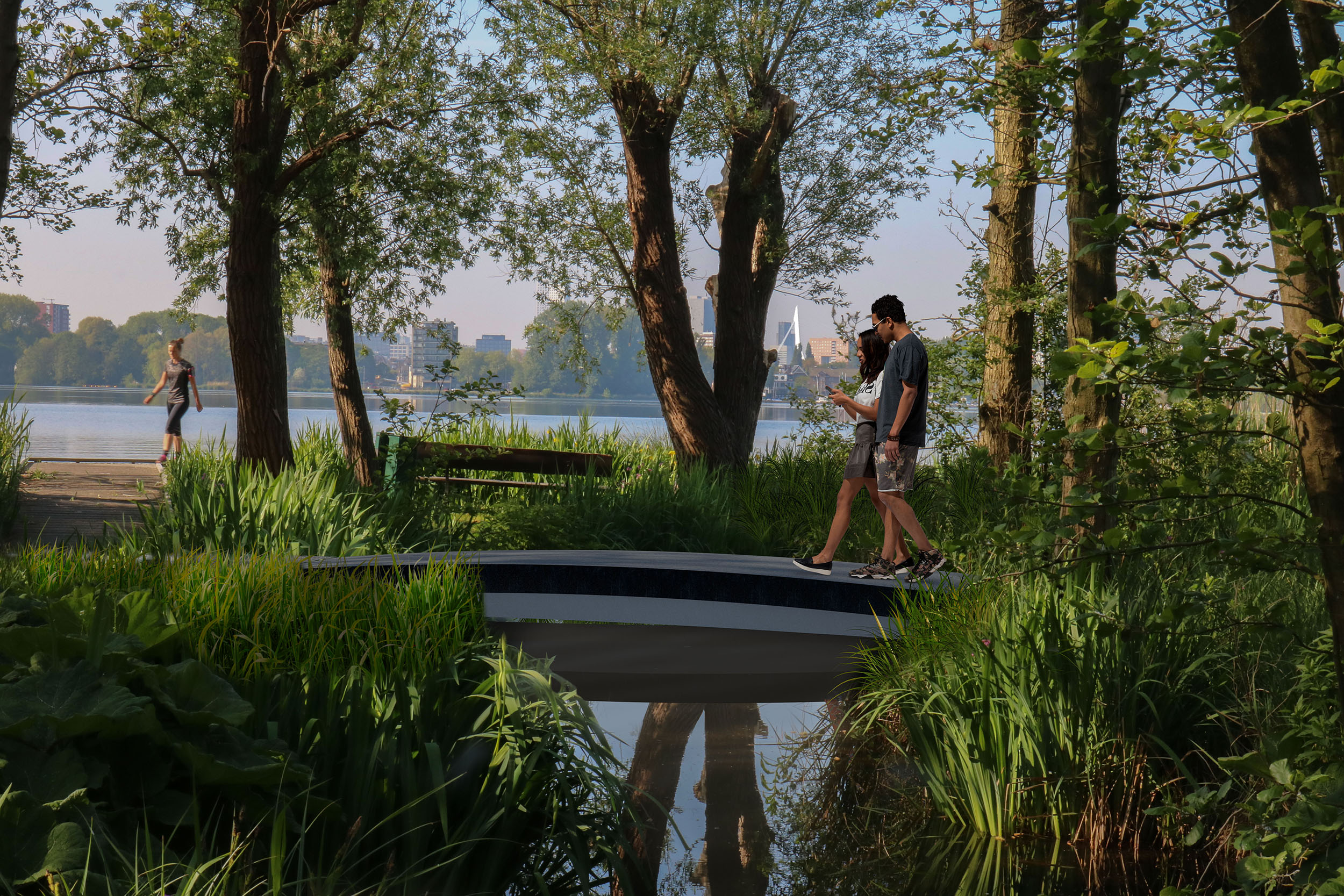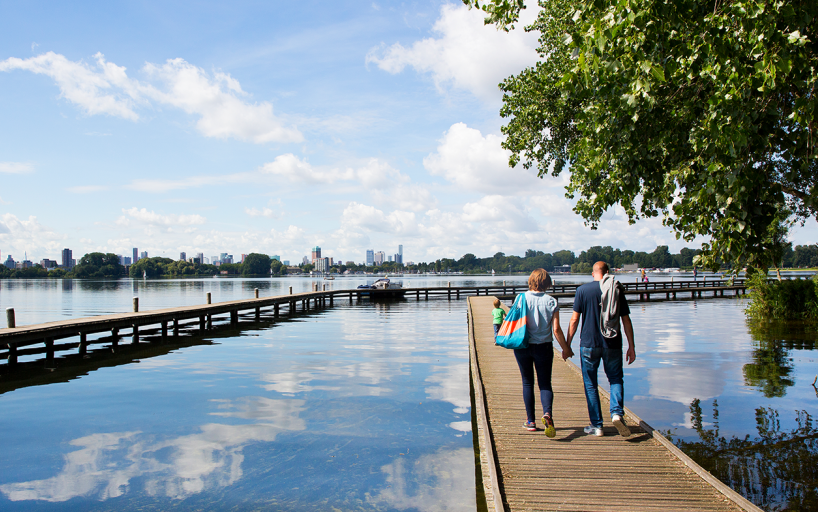Global nutritional science firm and materials producer DSM is working with Netherlands-based engineering consultancy firm Royal HaskoningDHV and the City of Rotterdam, to 3D print a footbridge from recyclable source materials.
Set to be installed in the green heart of Rotterdam’s bustling Kralingse Bos park district, the bridge will be the first to utilize fiber-reinforced thermoplastics (FRPs) for this purpose. Set to be opened by the end of 2020, the companies are heralding the structure as the first in a new line of “next generation” 3D printed sustainable footbridges.
“The city of Rotterdam is proud to be a leader in the smart and circular use of composite bridges,” said Mozafar Said, Asset Manager from the City of Rotterdam. “Together with Royal HaskoningDHV and DSM, we are continuing to push the frontiers of sustainability for bridges, using thermoplastics which will enable greater circularity.”

DSM’s materials in the 3D printing industry
Based in the Dutch city of Heerlen, and known as a manufacturer of 3D printing materials, DSM has often entered into partnerships in order to expand the capabilities of its products. In a collaboration with car manufacturer Toyota in 2017 for instance, the company developed its Somos Taurus range of materials. The plastics, which demonstrated properties that were only previously producible in FFF and SLS methods, were used by Toyota to prototype parts for its race cars.
This was followed by deals with Digital Composite Manufacturing (DCM) company Fortify and 3D printing startup Origin in 2019, to create new 3D printing materials. DSM’s photopolymers were also optimized for Origin’s programmable P3 3D printing platform as part of the agreement. Further collaborations with British supercar manufacturer Briggs Automotive Company (BAC), and later 3D printing engineering and consulting firm JuggerBot 3D, confirmed the company’s ambition to expand the applications of its products into new industries.
Since then, DSM has begun working closely with Royal HaskoningDHV. Not only did the companies announce their plans to work together on Rotterdam’s bridge project in September 2019, but they also collaborated on DSM’s digital workflow platform. Royal HaskoningDHV helped to create the software, and acted as a lead customer, as DSM worked with six startups to develop the platform. Now the Dutch duo will take the next step in their collaboration, and begin producing the innovative new sustainably-sourced structure in Rotterdam.
“We announced the prototype of this circular composite bridge in 2019 and with the vision and support of our partners DSM and the City of Rotterdam we can now take this one step further,” said Maurice Kardas, Business Development Manager at Royal HaskoningDHV. “This is a step change which signifies a collective effort to bring innovation from idea to realization, and ushers in a new era of sustainable design and bridge functionality.”

Necessity of the “world’s first” FRP footbridge
According to the United Nations, rising sea levels caused by climate change, could have a severe effect on low-lying countries such as the Netherlands, unless dramatic changes are made to its methods of production. As a result, the port city of Rotterdam has embarked on a variety of eco-friendly initiatives ranging from floating farms to eco-tourism in recent years. In this context, it’s hardly surprising that the city’s local government has partnered up with two fellow Dutch companies, to work on what they’re describing as the “world’s first” printed FRP bridge.
“The 3D printed FRP footbridge as a circular composite aligns with our city’s ambitious sustainability targets to reduce carbon footprint and promote liveability, and we are proud to be the first city to test, print and install it,” explained Said.
Local infrastructure experts in composite bridges will be closely involved in the design and construction process, and the footbridge will be developed strictly in line with the highest standards of safety for bridge design. To support this, the companies are considering installing sensors on the footbridge, in order to build a digital twin of the structure. This could enable safety experts to predict and optimise maintenance of the bridge, ensuring its safety and extending its lifespan.
DSM’s Arnite thermoplastic material, which combines high performance with circularity, will be used to construct the footbridge. If the eco-friendly composites prove to be strong and versatile enough, the local government is considering using the materials to construct “bridges of the future,” with the potential to replace other ageing structures in the city centre. “We see the use of composite bridges as a smart solution to replacing our older constructions,” added Said. “With more than 1000 bridges in Rotterdam, we are constantly looking to push the boundaries to develop the next generation of bridges, which will be more sustainable and circular with lower maintenance and lifecycle costs.”
“The printed circular composite bridge enables the transition to a more sustainable and circular type of bridges with minimal wear and tear,” concluded Patrick Duis, Senior Application Development Specialist Additive Manufacturing at DSM. “Now that we have the new circular composite of recyclable source material along with the required performance properties available to us, we can start taking the environment-friendly design of the infrastructure to the next level.”
Bridging the gap to modern manufacturing?
While the 3D printed footbridge being created in Rotterdam may be the first to use FRPs in its construction, a number of innovative additive bridges have been built in recent years. Netherlands-based 3D concrete printing specialist Vertico for instance, collaborated with the University of Ghent to 3D print an optimized and material efficient footbridge. Utilizing its concrete printing process, the firm reduced the amount of materials used by 60 percent.
Similarly, Chinese construction company, Shanghai Mechanized Construction Group Co (SMCC) and 3D printing filament manufacturer Polymaker, partnered to 3D print a pedestrian bridge in Shanghai. The bridge was installed in the Taopu Smart City, which was built as a “compact energy-saving city.”
A team of engineers from the U.S. Army Engineer Research and Development Center (ERDC) also used 3D printing to produce a 32-ft-long reinforced concrete footbridge. The team aimed to establish additive construction as a viable method, and introduce the benefits of large-scale 3D printing into military use.
You can now nominate for the 2020 3D Printing Industry Awards. Cast your vote to help decide this year’s winners.
To stay up to date with the latest 3D printing news, don’t forget to subscribe to the 3D Printing Industry newsletter or follow us on Twitter or liking our page on Facebook.
Looking for a job in the additive manufacturing industry? Visit 3D Printing Jobs for a selection of roles in the industry.
Featured image shows concept art of what the 3D printed bridge in Rotterdam will look like. Image via DSM.



